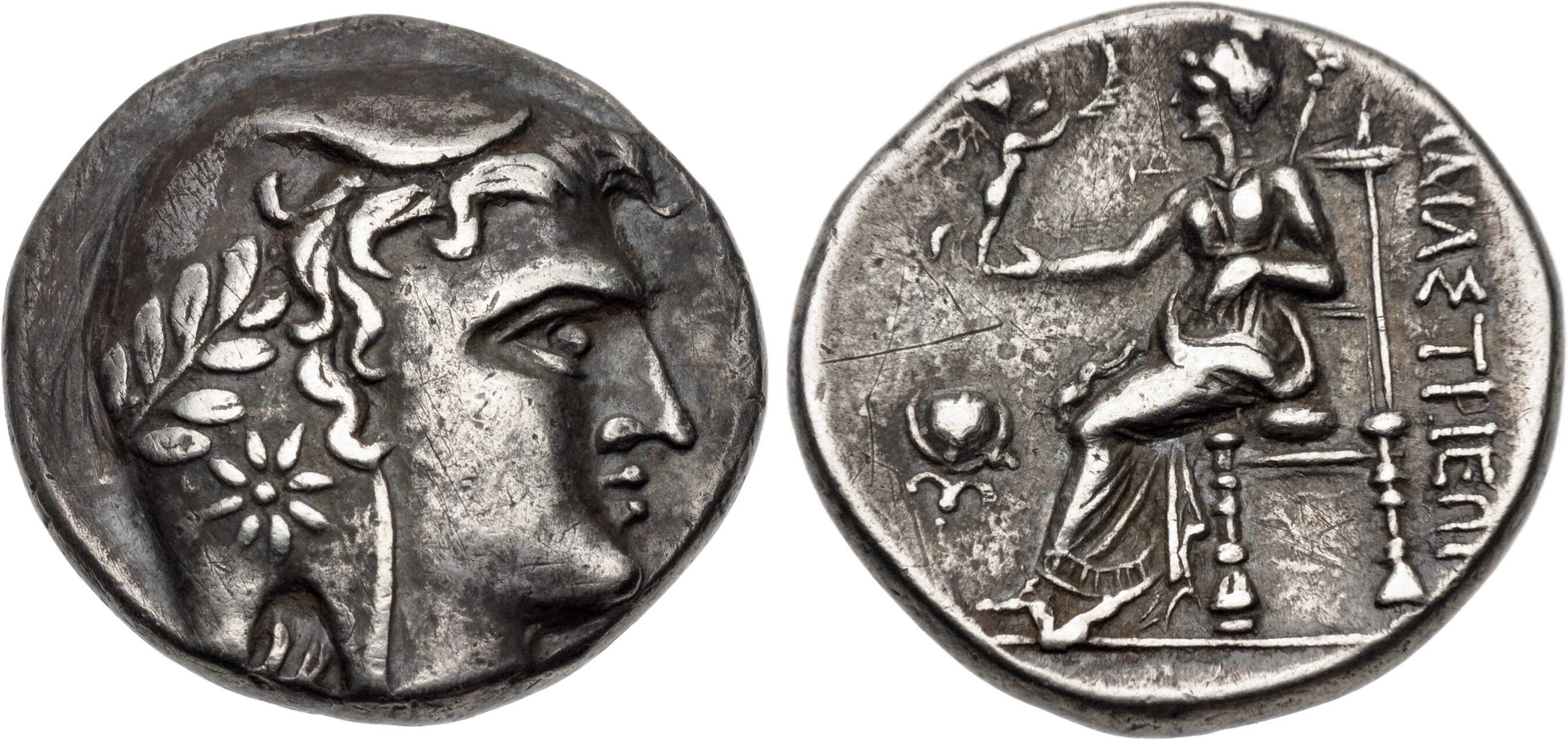Amastris, silver, staters (Men/Amastris) (300-285 BCE)
From SILVER
300 BCE - 285 BCE Silver 2,871 kg
Description
| ObverseInscription or printing placed on the obverse.: | Head of Men (better than Queen Amastris) right wearing Phrygian headdress ornamented in star and wreath |
| ReverseInscription or printing placed on the reverse.: | ΑΜΑΣΤΡΙΕΩΝ (Greek).Amastris (better than Aphrodite) seated left holding wreath-bearing Nike, rose on left and monogram below seat |
Mint and issuing power
| MintIdentifies the place of manufacture or issue of a numismatic object.: | Amastris | Ancient regionAncient region.: | Paphlagonia | Modern countryModern country: Turkey | AuthorityIdentifies the issuing power. The authority can be "pretended" when the name or the portrait of X is on the coin but he/she was not the issuing power. It can also be "uncertain" when there is no mention of X on the coin but he/she was the issuing power according to the historical sources: | Amastris (Persian princess, wife of Craterus, Dionysius and Lysimachus, c. 330-284 BC) |
Chronology
| FromIdentifies the initial date in a range assigned in a numismatic context. | 300 BCE | toIdentifies the final date in a range assigned in a numismatic context.. | 285 BCE | PeriodTime period of the numismatic object.: Hellenistic 323-30 BC |
Physical description
| MetalThe physical material (usually metal) from which an object is made.: | Silver |
Median weightMedian of the weights of numismatic objects (in grams). in grams | 9.50 | DenominationTerm indicating the value of a numismatic object. Examples: tetradrachm, chalkous, denarius.: | stater |
StandardStandard.: | Attic |
Image

RQEM ad. 267 - Amastris, silver, stater, 300-285 BC.jpg [1]
References
| Die study referencePublication of the study: | Callataÿ 2004b1Callataÿ 2004b, p. 67-71, n° 20-52. | ||
| Coin series referenceReference to coin series study: | HGC 72HGC 7, n° 356 | ||
| Coin series web referenceCoin series web references: | |||
Obverse dies distribution
| FrequencyFrequency of specimen in distribution. ᵖ | Number of obversesNumber of obverse dies. ᵖ (o) | % (o) | Number of coinsNumber of coins. (n) | % (n) | Die nameName(s) of the die(s). |
| 1 | 6 | 42.86 | 6 | 7.23 | |
| 2 | 1 | 7.14 | 2 | 2.41 | |
| 3 | 1 | 7.14 | 3 | 3.61 | |
| 4 | 3 | 21.43 | 12 | 14.46 | |
| 5 | 1 | 7.14 | 5 | 6.02 | |
| 14 | 1 | 7.14 | 14 | 16.87 | |
| 41 | 1 | 7.14 | 41 | 49.4 | |
| Total | 14 of 14 | 99.99 | 83 of 83 | 100 |
Reverse dies distribution
no distribution is available
Quantification
| Number of obversesNumber of obverse dies. ᵖ (o) | 14 | Number of singletons (o1)The number of singleton coins. ᵖ | 6 |
| Number of reverse diesNumber of reverse dies. (r) | 29 | Number of coinsNumber of coins. (n) | 83 |
| Coins per obverse dieNumber of coins per obverse die. (n/o) | 5.93 | Coins per reverse dieNumber of coins per reverse die. (n/r) | 2.86 |
| Reverse per obverse ratioRatio of obverse dies divided by reverse dies. (r/o) | 2.07 | Percentage of singletons (o1)number of coins (n) divided by the number of singletons (o1) ᵖ | 42.86 % |
| Original number of dies (O) (Carter 1983 formula)The estimation of the number of coins according to Carter 1983 ᵖ | 15.11 | Coins struck if 20,000 as average productivity per dieCoins made if the average productivity for obverses (according to Carter) is 20,000. ᵖ | 302,200 |
| Original number of dies (O) (Esty 2011 formula)The estimation of the number of coins according to the singleton formula in Esty 2011 ᵖ (O) | 16.84 | Survival rate if 20,000 as average productivity per dieSurvival rate if average productivity is 20,000. ᵖ | 0.00027 |
| Coverage (o = % of O) (Esty 1984 formula)Esty 1984 - coverage (% of O) ᵖ (o = % of O) | 92.77% | Die productivity if survival rate 1/2,000Average productivity if survival rate is 1/2,000. ᵖ | 10,986.1 |
| Weight of silver (in kg) if 20,000 coins per die (O = Carter formula)Carter 1983 * Median weight * 20000 (*10 if gold or electrum) ᵖ | 2,871 kg <br /> 2,871 kg | Die productivity if survival rate 1/5,000Average productivity if survival rate is 1/5,000. ᵖ | 27,465.25 |
Remarks
Most likely one single workstation
References
- ^ Callataÿ, François de (2004), "Le premier monnayage de la cité d'Amastris (Paphlagonie)", Schweizerische Numismatische Rundschau, 83, p. 57-80, pl. 9-11.
- ^ Hoover, Oliver D. (2012), Handbook of Greek Coinages. 7. Coins of northern and Central Anatolia - Pontos, Paphlagonia, Bithynia, Phrygia, Galatia, lykaonia, and Kappadokia (with Kolchis and the Kimmerian bosporos), Lancaster, lxxxii, 352 p. : ill. ; 23 cm.